This simulation is intended to provide learners with an approach to electronic fetal heart monitoring (EFM), exposure to various EFM tracings, and guide discussion on potential causes and clinical actions for normal, atypical, and abnormal tracings.
This simulation presents learners with various snapshots of scenarios with EFM tracings to stimulate discussion around potential causes and clinical actions.
This simulation is intended to provide learners with an approach to electronic fetal heart monitoring (EFM), exposure to various EFM tracings, and guide discussion on potential causes and clinical actions for normal, atypical, and abnormal tracings.
PART (A): includes four snapshots with debrief discussion involving:
Part (B): includes four snapshots with debrief discussion involving:
This simulation is part of ØRECLESS (Rural Emergencies and Complications in Labour Events Simulations Suite).
Overall Goal: Practice systematic interpretation of Electronic Fetal Monitoring (EFM) and management of atypical and abnormal tracings.
Specific Learning Objectives:
Time Recommended: 60 minutes total (Scenario & Debrief: 15 min./Case)
|
This SIM requires one learner. Supporting roles can (1) be assigned to complete tasks by the learner, (2) provide assistance with maneuvers, and (3) provide statements throughout the SIM to allow for progression through the stages.
|
Moulage: N/A.
Set-Up: The facilitator will present the relevant case scenario and EFM tracing (see Printable Supporting Documents).
Note: While prepping for your simulation, don't forget to prep for the debrief. Become comfortable with your chosen framework, review your objectives. For additional debriefing resources, see our Resources page.
Original Author: Tiana Bressan
Originally published on: December 4, 2023
Most Recent Modification:
A good prebriefing is an essential component of running effective simulations, as it sets the stage for everything that comes after it1-3. An effective prebrief will create a safe container for learning, and in doing so, help participants feel more comfortable pushing their limits, sharing their thoughts and feelings, and buying into the experience. In turn, this will enhance engagement, participation, and learning. To that end, the prebriefing process needs to cover a lot of information1-5, which can make it daunting to novice or non-expert facilitators. To help, we have consulted the relevant literature and put together a prebrief guide to ensure that you have the tools you need to run an effective pre-briefing session.
Throughout the pre-brief, it is important that you convey your commitment to respecting learners and their perspective2-4, and establish and maintain the simulation as a safe space for learning1,4,5.
Prebrief Guide (Sample Phrases in Italics)
Welcome learners. Introduce yourself, your role, and your experience with simulation.
Go over the time requirements for the simulation, when breaks will occur, how learners should handle incoming calls or texts, etc.
Clarify the learning objectives for the simulation1-5. Give information on the purpose of the simulation without giving out specific actions or information that might compromise the learning experience for participants.
Explain how participants will be evaluated (formative/summative/not evaluated). Briefly discuss the debrief process that will take place at the end of the simulation.
Give details on what expectations are for the learners' behaviour during the simulation, setting basic ground rules2-5. Go over expectations for yourself as the facilitator. Reinforce the simulation as a learning environment, where mistakes aren't something to be punished but opportunities for further learning.
This could be a good place to pause and ask learners if they have any additional expectations, fears, comments, or questions about the topic for the day.
Ensure all participants agree to the confidentiality expectations of the simulation. Often, this will follow the mantra of "What happens in the simulation stays in the simulation," where learners and instructors agree not to share information on others' performance or scenario details outside of the simulation environment.
Explain that you've done what you can to make the simulation as real as possible, but acknowledge the limitations. Ask the learner to commit to doing what they can to act as if everything was real, explaining that the quality of their learning will depend on their willingness to participate as fully as possible. For the first simulation with a new group, it could be helpful to explain the importance of a mutual fiction contract.
Explain the different roles in the simulation and assign learners to them. If you have predetermined scripts for certain roles, hand them out here.
Explain the resources that will be available for the participants to use, how they should call for help in the simulation, what your role will be in providing information.
Orient participants to simulation space, equipment, manikin, etc. This can also be done by allowing participants to explore the simulation space and manikin for themselves.
Ask for questions!
References
1. Rudolph JW, Raemer DB, Simon R. Establishing a safe container for learning in simulation: the role of the presimulation briefing. Simul Healthc. 2014 Dec;9(6):339-49. doi: 10.1097/SIH.0000000000000047. PMID: 25188485.
2. Leigh G, Steuben F. Setting Learners up for Success: Presimulation and Prebriefing Strategies. Teaching and Learning in Nursing. 2018; 13(3):185-189. https://doi.org/10.1016/j.teln.2018.03.004
3. Lecomte F, Jaffrelot M. Chapter 33 - Prebriefing and Briefing. Clinical Simulation. 2019; 2nd ed.; 471-482. https://doi.org/10.1016/B978-0-12-815657-5.00034-6.
4. INACSL Standards Committee (2016, December). INACSL standards of best practice: SimulationSM Facilitation. Clinical Simulation in Nursing, 12(S), S16-S20. http://dx.doi.org/10.1016/j.ecns.2016.09.007.
5. Simon R, Raemer D, Rudolph J. Rater's handbook for the Debriefing Assessment for Simulation in Healthcare (DASH) Rater Version. 2009. http://www.harvardmedsim.org/debriefing-assesment-simulation-healthcare.php.
The following EFM Interpretation Approach is available for reference but not required for each snapshot.
| Expected Learner Actions |
|---|
|
Auscultation - see Intermittent Auscultation During Labour (not required in this SIM). |
|
|
Dilation: 6cm
Fetal Station: 0
Effacement: 80%
Membrane: Absent
Overt umbilical cord prolapse and the presence of pulsations within the cord vessels.
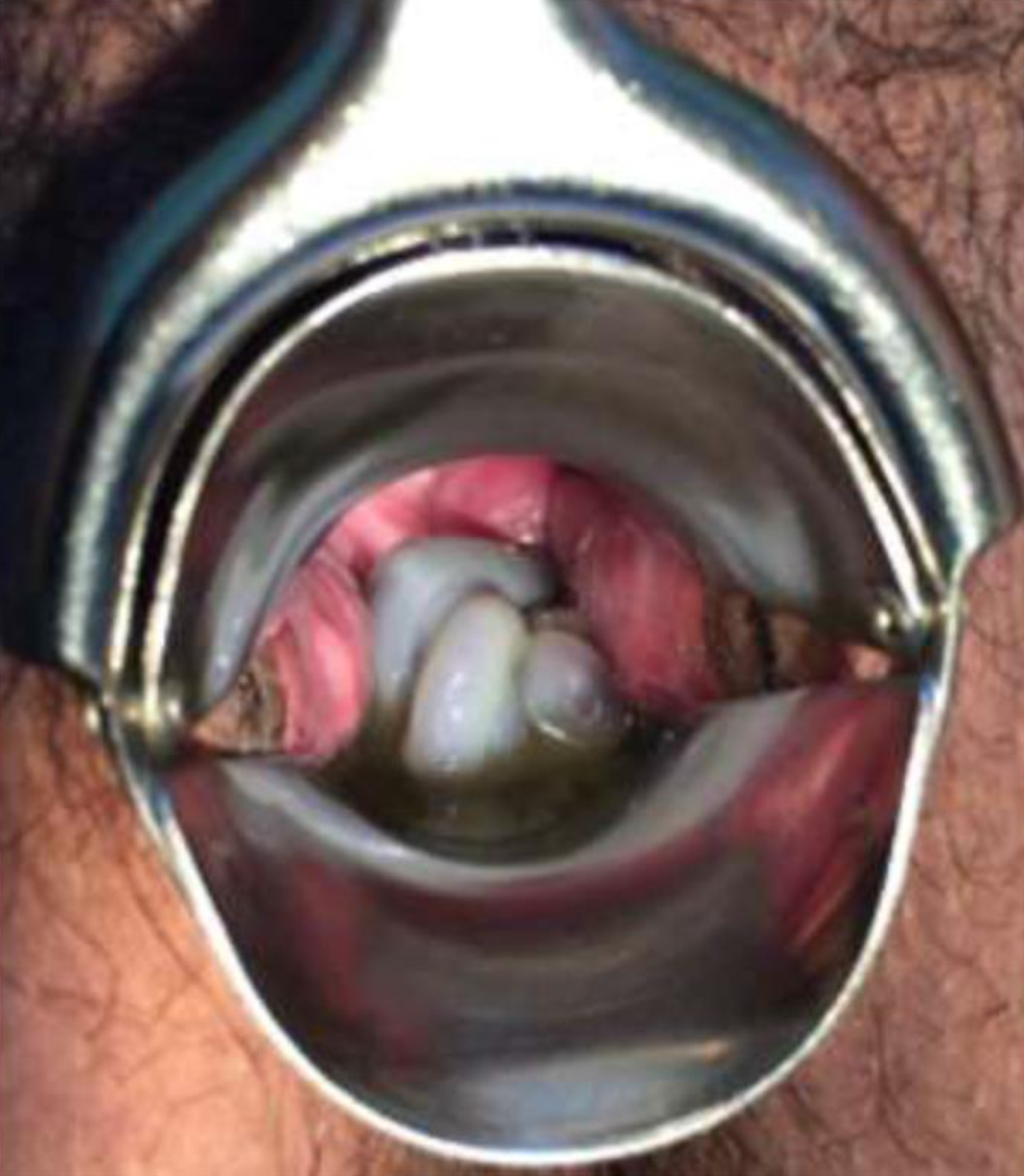
Park, M., Jung, Y.W., Park, J. et al. Successful delayed delivery of the second twin by evacuating the cord prolapsed first fetus and emergent cerclage: a report of 2 cases.BMC Pregnancy Childbirth 22, 113 (2022). https://doi.org/10.1186/s12884-022-04438-z
This simulation presents learners with various snapshots of scenarios with EFM tracings to stimulate discussion around potential causes and clinical actions.
This simulation is intended to provide learners with an approach to electronic fetal heart monitoring (EFM), exposure to various EFM tracings, and guide discussion on potential causes and clinical actions for normal, atypical, and abnormal tracings.
PART (A) includes four snapshots with debrief discussion involving:
1. Interpret the EFM Tracing – Contractions, Baseline Rate, Variability, Acceleration, Deceleration.
2. Classify as normal, atypical, or abnormal.
3. Describe the next clinical action(s) you would take.
Case #1: Normal with Accelerations
Case #2: Bradycardia
Case #3: Tachycardia
Case #4: Sinusoidal Variability
Further History:
| Physical Exam | |
| Cardio: | Neuro: |
| Resp. | Head & Neck: |
| Abdo: | MSK/Skin: |
| Other: | |
You’re on call for obstetrics in a rural 1A maternity site (no local cesarean section capabilities), and the nearest urban centre is 500 km away. While fishing off your DIY wooden dock, you get called in.
38 y/o woman presents to the ED following membrane rupture with contractions q5min lasting approximately 70 seconds. Upon vaginal examination, she was 8 cm dilated and 100% effaced. Due to weakening contractions, oxytocin was administered (10 U IM). During auscultation, there were suspected changes between contractions. An EFM was applied (attached).
Note(s):
Age: 38 | Weight: 73kg | Height: 155cm | Pronouns: She/Her
Labs are normal. Rh positive. GBS negative.
Pregnancy complication(s): Gestational diabetes.
Medication(s): Insulin Lispro at mealtimes (throughout the last trimester).
Allergies: None.
| Patient Vitals | ||||||
| Gestation: 40 Weeks (G3P2) | HR: 99bpm | BP: 110/82 | RR: 22/min | |||
| O2SAT: 99% | T: 36.5 degrees Celcius | GCS: 15 | ||||
Interpret the EFM. What is your next step?
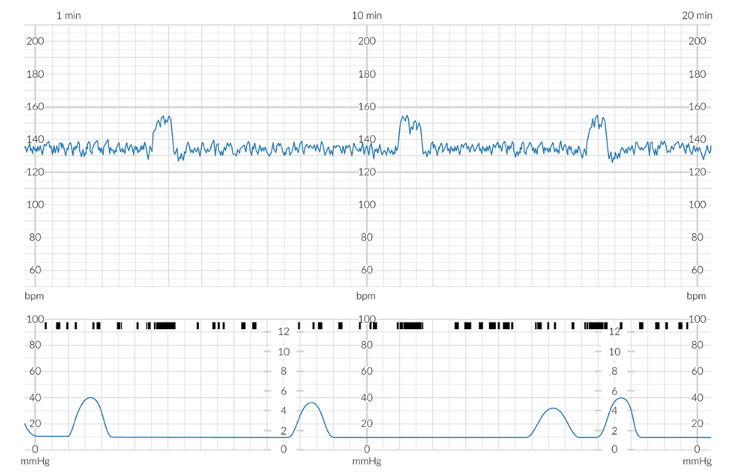
Figure: Retrieved July 14, 2023, from https://www.amboss.com/us/knowledge/normal-labor-and-delivery/
Interpretation: Normal
Uterine Activity: 2 contractions q10 minutes
FHR: 135bpm
Variability: Moderate (~10bpm)
Clinical Action(s):
Dilation: 6cm
Fetal Station: 0
Effacement: 80%
Membrane: Absent
Overt umbilical cord prolapse and the presence of pulsations within the cord vessels.

Park, M., Jung, Y.W., Park, J. et al. Successful delayed delivery of the second twin by evacuating the cord prolapsed first fetus and emergent cerclage: a report of 2 cases.BMC Pregnancy Childbirth 22, 113 (2022). https://doi.org/10.1186/s12884-022-04438-z
You’re on call for obstetrics in a rural 1A maternity site (no local cesarean section capabilities), and the nearest urban centre is 300 km away. While planting the last row of potatoes in your 1100 square foot garden (that you’re really proud of), you get called in.
22 y/o woman presents to the ED following membrane rupture with contractions q5min lasting approximately 60 seconds. An EFM was applied (attached) due to antepartum preeclampsia risk.
Note(s):
Age: 22 | Weight: 68kg | Height: 165cm | Pronouns: She/Her
Labs are normal. Rh positive. GBS negative.
Pregnancy complication(s): Preeclampsia.
Medication(s): Labetalol.
Allergies: Penicillin.
| Patient Vitals | ||||||
| Gestation: 39 Weeks (G1P0) | HR: 110bpm | BP: 107/72 | RR: 24/min | |||
| O2SAT: 99% | T: 36.7 degrees Celcius | GCS: 15 | ||||
Interpret the EFM. What is your next step?
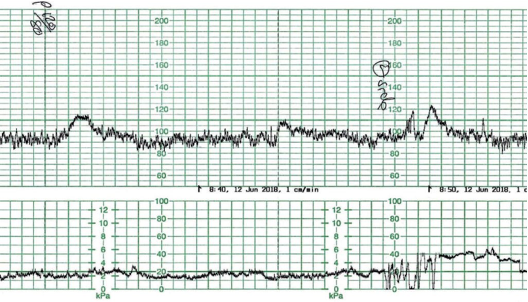
Figure: Retrieved July 14, 2023, from https://www.ogmagazine.org.au/19/2-19/the-fetal-bradycardia/
Interpretation: Abnormal - see Bradycardia
Uterine Activity: N/A
FHR: 90-95bpm
Variability: Moderate (~10bpm)
Potential Cause: Maternal medication
Note: Normal variability and accelerations suggest the fetus is well-oxygenated. In the absence of maternal medication, baseline bradycardia is most likely due to a mature parasympathetic nervous system
Clinical Action(s):
Dilation: 6cm
Fetal Station: 0
Effacement: 80%
Membrane: Absent
Overt umbilical cord prolapse and the presence of pulsations within the cord vessels.

Park, M., Jung, Y.W., Park, J. et al. Successful delayed delivery of the second twin by evacuating the cord prolapsed first fetus and emergent cerclage: a report of 2 cases.BMC Pregnancy Childbirth 22, 113 (2022). https://doi.org/10.1186/s12884-022-04438-z
You’re on call for obstetrics in a rural 1A maternity site (no local cesarean section capabilities), and the nearest urban centre is 640 km away. While attending your first cousin’s, neighbour’s, grandchild’s 8th birthday party, you get called in.
40 y/o woman presents to the ED stating that she felt “leaking” yesterday morning and started experiencing abdominal tightening this morning. She also feels “under the weather” today. She’s having contractions q3min lasting approximately 80 seconds. Upon vaginal examination, she was 10 cm dilated, 100% effaced, and there was fluid pooling in the posterior fornix. An EFM was applied (attached).
Note(s):
Age: 40 | Weight: 82kg | Height: 168cm | Pronouns: She/Her
Labs are normal. Rh positive. GBS negative.
Pregnancy complication(s): None.
Medication(s): None.
Allergies: None.
| Patient Vitals | ||||||
| Gestation: 41 Weeks (G5P4) | HR: 115bpm | BP: 105/87 | RR: 22/min | |||
| O2SAT: 99% | T: 38.2 degrees Celcius | GCS: 15 | ||||
Interpret the EFM. What is your next step?

Figure: Retrieved July 14, 2023, from http://www.learningaboutelectronics.com/Articles/Fetal-tachycardia.php
Interpretation: Abnormal - see Tachycardia
Uterine Activity: 3 contractions q10 minutes
FHR: 180bpm
Variability: Moderate (~10bpm)
Potential Cause: Fever
Clinical Action(s):
Dilation: 6cm
Fetal Station: 0
Effacement: 80%
Membrane: Absent
Overt umbilical cord prolapse and the presence of pulsations within the cord vessels.

Park, M., Jung, Y.W., Park, J. et al. Successful delayed delivery of the second twin by evacuating the cord prolapsed first fetus and emergent cerclage: a report of 2 cases.BMC Pregnancy Childbirth 22, 113 (2022). https://doi.org/10.1186/s12884-022-04438-z
You’re on call for obstetrics in a rural 1A maternity site (no local cesarean section capabilities), and the nearest urban centre is 640 km away. You’re about to put your homemade dough into the oven (because who doesn’t love fresh bread) when you get called in.
31 y/o woman presents to the ED following membrane rupture with contractions q5min lasting approximately 90 seconds. Upon vaginal examination, she was 8 cm dilated and 100% effaced. During auscultation, there were suspected baseline changes between contractions. An EFM was applied (attached).
Note(s):
Age: 31 | Weight: 86kg | Height: 172cm | Pronouns: She/Her
Labs are normal. Rh positive. GBS negative.
Pregnancy complication(s): None.
Medication(s): None.
Allergies: None.
| Patient Vitals | ||||||
| Gestation: 40+2 Weeks (G4P3) | HR: 92bpm | BP: 121/85 | RR: 23/min | |||
| O2SAT: 99% | T: 36.8 degrees Celcius | GCS: 15 | ||||
Interpret the EFM. What is your next step?

Figure: Retrieved July 14, 2023, from https://geekymedics.com/how-to-read-a-ctg/
Interpretation: Abnormal - see Sinusoidal Variability
Uterine Activity: 2 contractions q10 minutes
FHR: 130bpm
Variability: Sinusoidal
Potential Cause:
Clinical Action(s):
Dilation: 6cm
Fetal Station: 0
Effacement: 80%
Membrane: Absent
Overt umbilical cord prolapse and the presence of pulsations within the cord vessels.

Park, M., Jung, Y.W., Park, J. et al. Successful delayed delivery of the second twin by evacuating the cord prolapsed first fetus and emergent cerclage: a report of 2 cases.BMC Pregnancy Childbirth 22, 113 (2022). https://doi.org/10.1186/s12884-022-04438-z
This simulation presents learners with various snapshots of scenarios with EFM tracings to stimulate discussion around potential causes and clinical actions.
This simulation is intended to provide learners with an approach to electronic fetal heart monitoring (EFM), exposure to various EFM tracings, and guide discussion on potential causes and clinical actions for normal, atypical, and abnormal tracings.
PART (B) includes four snapshots with debrief discussion involving:
1. Interpret the EFM Tracing – Contractions, Baseline Rate, Variability, Acceleration, Deceleration.
2. Classify as normal, atypical, or abnormal.
3. Describe the next clinical action(s) you would take.
Case #1: Early Decelerations
Case #2: Variable Decelerations
Case #3: Late Decelerations
Case #4: Prolonged Decelerations
You’re on call for obstetrics in a rural 1A maternity site (no local cesarean section capabilities), and the nearest urban centre is 270 km away. You’re enjoying a cappuccino on your porch when you get called in.
27 y/o woman presents to the ED following membrane rupture with contractions q4min lasting approximately 90 seconds. Upon vaginal examination, she was 6 cm dilated and 80% effaced. During auscultation, there were suspected decelerations. An EFM was applied (attached).
Note(s):
Age: 27 | Weight: 74kg | Height: 157cm | Pronouns: She/Her
Labs are normal. Rh positive. GBS negative.
Pregnancy complication(s): None.
Medication(s): None.
Allergies: None.
| Patient Vitals | ||||||
| Gestation: 40 Weeks (G1P0) | HR: 95bpm | BP: 123/80 | RR: 23/min | |||
| O2SAT: 99% | T: 37.1 degrees Celcius | GCS: 15 | ||||
Interpret the EFM. What is your next step?
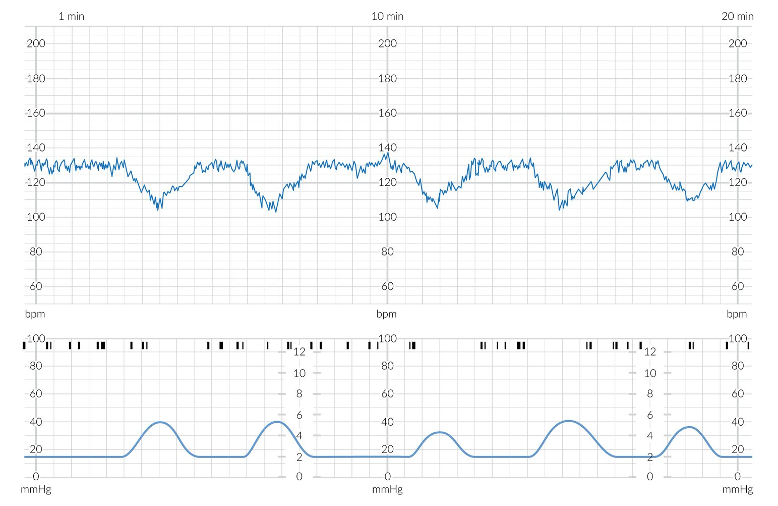
Figure: Retrieved July 14, 2023, from https://www.amboss.com/us/knowledge/normal-labor-and-delivery/
Interpretation: Normal - see Early Decelerations
Uterine Activity: 2-3 contractions q10 minutes
FHR: 130bpm
Variability: Moderate (~10bpm)
Clinical Action(s):
Dilation: 6cm
Fetal Station: 0
Effacement: 80%
Membrane: Absent
Overt umbilical cord prolapse and the presence of pulsations within the cord vessels.

Park, M., Jung, Y.W., Park, J. et al. Successful delayed delivery of the second twin by evacuating the cord prolapsed first fetus and emergent cerclage: a report of 2 cases.BMC Pregnancy Childbirth 22, 113 (2022). https://doi.org/10.1186/s12884-022-04438-z
You’re on call for obstetrics in a rural 1A maternity site (no local cesarean section capabilities), and the nearest urban centre is 430 km away. You’re locuming in a friendly community by the water, and as you think to yourself, “Wow, I love it here!” you get called in.
25 y/o woman presents to the ED following membrane rupture with contractions q10min lasting approximately 120 seconds. Upon vaginal examination, she was 5 cm dilated and 50% effaced. During auscultation, there were suspected decelerations. An EFM was applied (attached).
Note(s):
Age: 25 | Weight: 66kg | Height: 168cm | Pronouns: She/Her
Labs are normal. Rh negative. GBS positive.
Pregnancy complication(s): None.
Medication(s): None.
Allergies: None.
| Patient Vitals | ||||||
| Gestation: 39 Weeks (G1P0) | HR: 105bpm | BP: 105/74 | RR: 20/min | |||
| O2SAT: 99% | T: 37.3 degrees Celcius | GCS: 15 | ||||
Interpret the EFM. What is your next step?
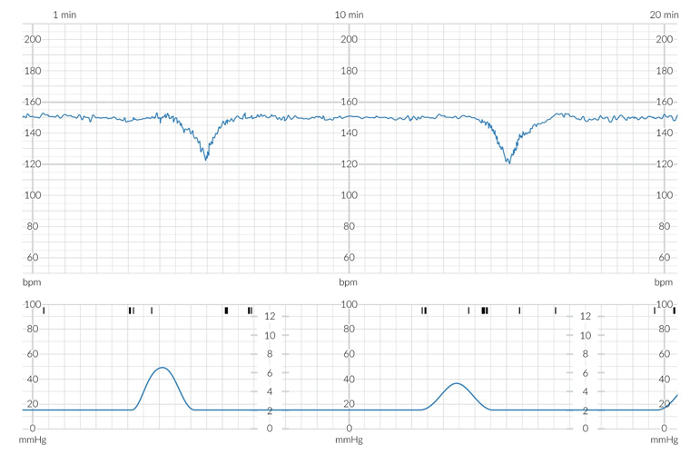
Figure: Retrieved July 14, 2023, from https://www.amboss.com/us/knowledge/normal-labor-and-delivery/
Interpretation: Abnormal - see Recurrent Late Decelerations
Uterine Activity: 1 contraction q10 minutes
FHR: 150bpm
Variability: Minimal (<6bpm)
Clinical Action(s):
Dilation: 6cm
Fetal Station: 0
Effacement: 80%
Membrane: Absent
Overt umbilical cord prolapse and the presence of pulsations within the cord vessels.

Park, M., Jung, Y.W., Park, J. et al. Successful delayed delivery of the second twin by evacuating the cord prolapsed first fetus and emergent cerclage: a report of 2 cases.BMC Pregnancy Childbirth 22, 113 (2022). https://doi.org/10.1186/s12884-022-04438-z
You’re on call for obstetrics in a rural 1A maternity site (no local cesarean section capabilities), and the nearest urban centre is 520 km away. While going for a walk, you jumped into a game of pick-up basketball and have since been destroying the competition. You get a call from the hospital.
17 y/o woman presents to the ED following membrane rupture with contractions q3-4min lasting approximately 90 seconds. Upon vaginal examination, she was 6 cm dilated and 80% effaced. During auscultation, there were suspected decelerations. An EFM was applied (attached).
Note(s):
Age: 17 | Weight: 61kg | Height: 158cm | Pronouns: She/Her
Labs are normal. Rh positive. GBS negative.
Pregnancy complication(s): None.
Medication(s): None.
Allergies: None.
| Patient Vitals | ||||||
| Gestation: 41 Weeks (G1P0) | HR: 106bpm | BP: 112/82 | RR: 23/min | |||
| O2SAT: 99% | T: 37.2 degrees Celcius | GCS: 15 | ||||
Interpret the EFM. What is your next step?
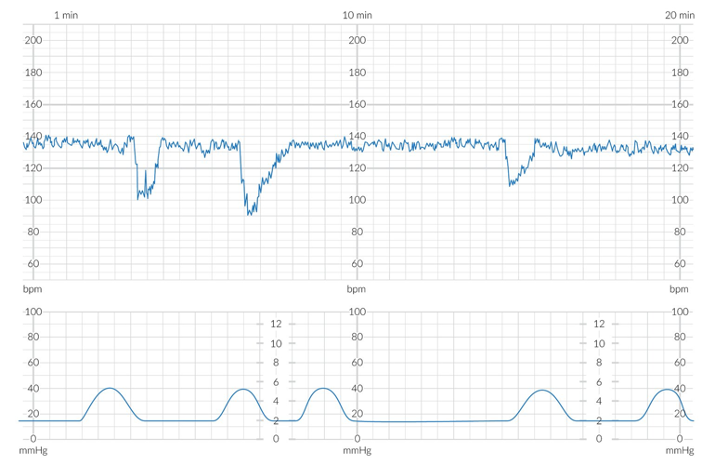
Figure: Retrieved July 14, 2023, from https://www.amboss.com/us/knowledge/normal-labor-and-delivery/
Interpretation: Atypical - see Variable Decelerations
Uterine Activity: 2-3 contractions q10 minutes
FHR: 136bpm
Variability: Moderate (~10bpm)
Clinical Action(s):
Dilation: 6cm
Fetal Station: 0
Effacement: 80%
Membrane: Absent
Overt umbilical cord prolapse and the presence of pulsations within the cord vessels.

Park, M., Jung, Y.W., Park, J. et al. Successful delayed delivery of the second twin by evacuating the cord prolapsed first fetus and emergent cerclage: a report of 2 cases.BMC Pregnancy Childbirth 22, 113 (2022). https://doi.org/10.1186/s12884-022-04438-z
You’re on call for obstetrics in a rural 1A maternity site (no local cesarean section capabilities), and the nearest urban centre is 340 km away. You’re just about to crack open your new book titled Homesteading for Beginners when you get called in.
38 y/o woman presents to the ED following membrane rupture. Due to weakening contractions, oxytocin was administered (8 mU/min IV). During auscultation, there were suspected baseline changes between contractions. An EFM was applied (attached).
Note(s):
Age: 38 | Weight: 84kg | Height: 171cm | Pronouns: She/Her
Labs are normal. Rh positive. GBS negative.
Pregnancy complication(s): None.
Medication(s): None.
Allergies: None.
| Patient Vitals | ||||||
| Gestation: 40+3 Weeks (G6P5) | HR: 94bpm | BP: 129/85 | RR: 20/min | |||
| O2SAT: 99% | T: 36.9 degrees Celcius | GCS: 15 | ||||
Interpret the EFM. What is your next step? Note: Approximately 3 minutes of tracing are shown.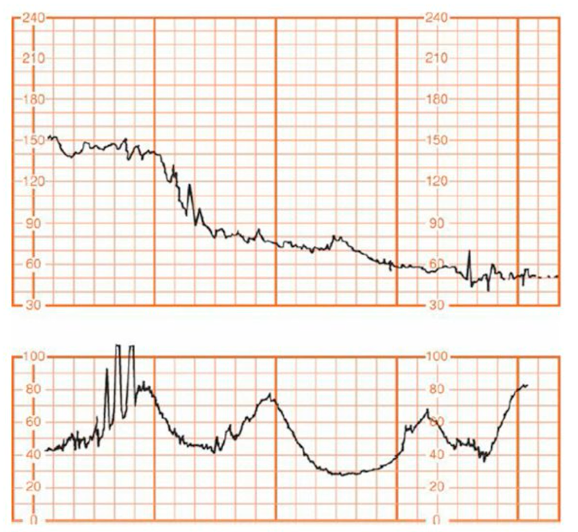
Figure: Retrieved July 20, 2023, from https://slideplayer.com/slide/5944289/
Interpretation: Abnormal - see Single Prolonged Deceleration
Uterine Activity: 3 contractions q3 minutes
FHR: 150bpm
Variability: Moderate (~10bpm)
Clinical Action(s):
Dilation: 6cm
Fetal Station: 0
Effacement: 80%
Membrane: Absent
Overt umbilical cord prolapse and the presence of pulsations within the cord vessels.

Park, M., Jung, Y.W., Park, J. et al. Successful delayed delivery of the second twin by evacuating the cord prolapsed first fetus and emergent cerclage: a report of 2 cases.BMC Pregnancy Childbirth 22, 113 (2022). https://doi.org/10.1186/s12884-022-04438-z
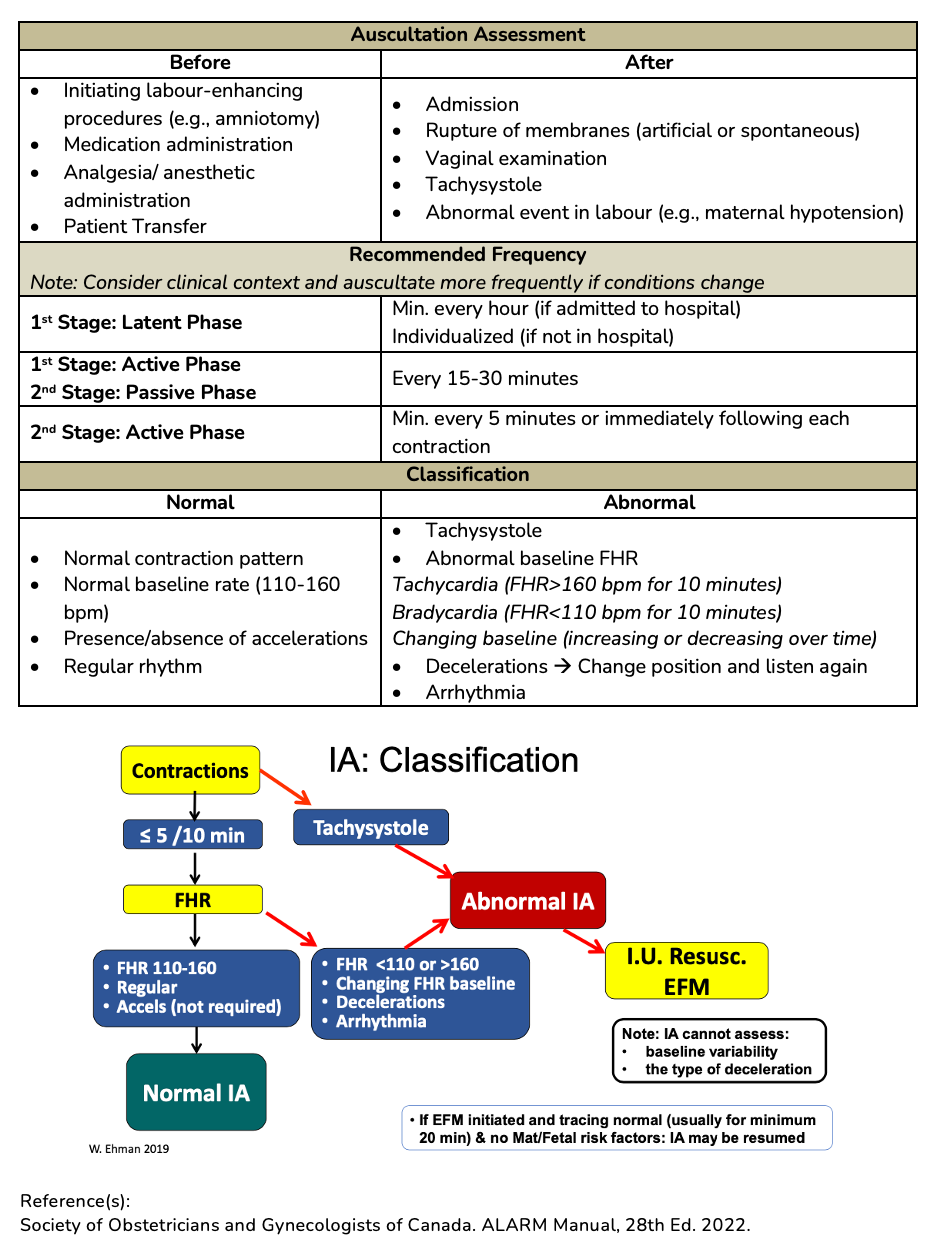

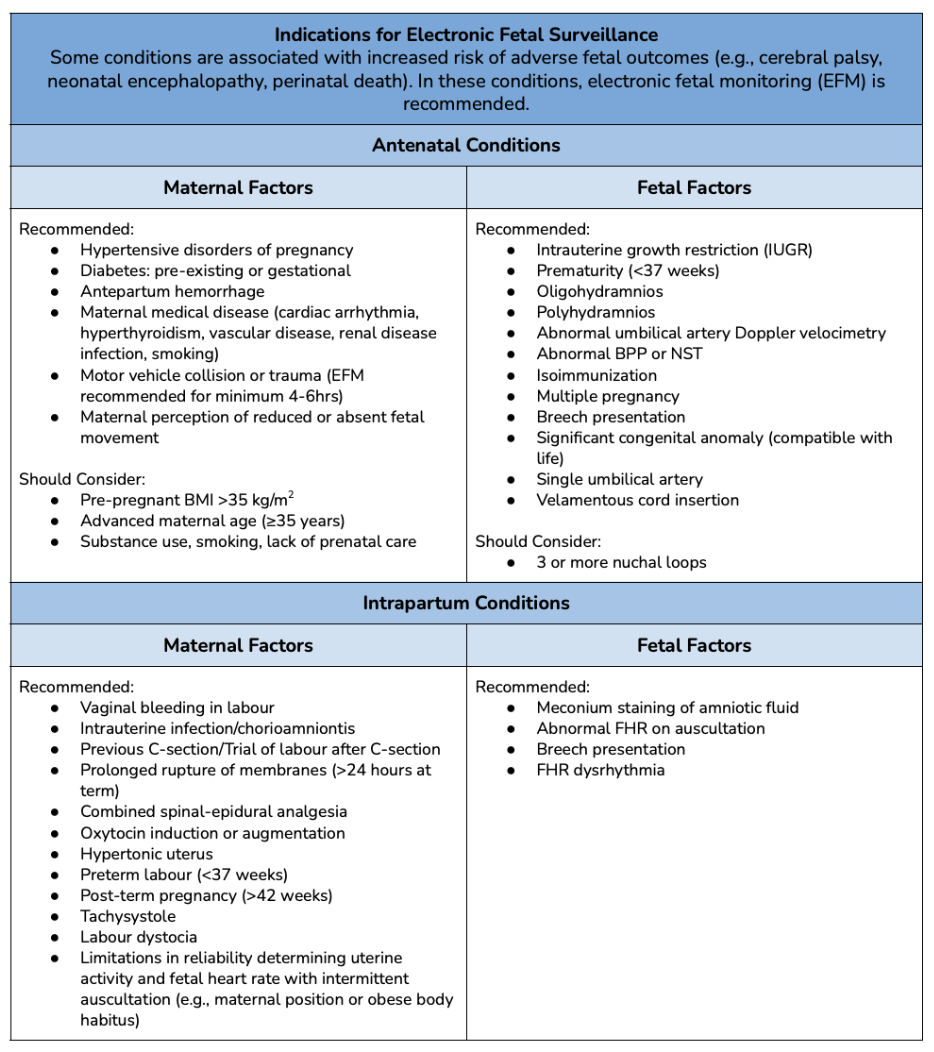
Reference(s):
Society of Obstetricians and Gynecologists of Canada. ALARM Manual, 28th Ed. 2022.
| FHR Pattern (VEAL) | Cause (CHOP) | Management (MINE) | |||
| V | Variable Deceleration | C | Cord Compression | M | Maternal Repositioning |
| E | Early Deceleration | H | Head Compression | I | Identify Labour Progress |
| A | Acceleration | O | Okay! | N | No Intervention |
| L | Late Deceleration | P | Placental Insufficiency | E | Evaluate (reposition, fluids, oxygen, emergency delivery). |
Retrieved July 17, 2023, from Melbourne University Obstetrics and Gynecology Society (Facebook)
|
Assessing Contraction Pattern |
|||||||||||
|
Methods of Assessment |
|||||||||||
|
Palpation by Hand
|
Tocodynamometer (external)
|
Internal Intrauterine Pressure Catheter (IUPC)
|
|||||||||
|
Characteristics of Contractions |
|||||||||||
|
Frequency |
Duration |
Intensity |
Resting Tone |
||||||||
|
# of contractions in 10 minutes, averaged over 30 minutes Normal: ≤ 5 in 10 mins |
# of seconds from beginning to end of contraction Normal: <90 s |
Strength of contraction By palpation if using tocodynamometer: mild, moderate, or strong (strong = uterus cannot be indented) Normal (IUPC): 25-75 mmHg above baseline |
Firmness between contractions Palpation: soft or firm Normal (palpation): soft between contractions for at least 30s to allow for placental perfusion Normal (IUPC): 7-25 mmHg |
||||||||
|
Abnormal Contraction Pattern |
|||||||||||
|
Tachysystole - excessive uterine activity (commonly d/t exogenous augmentation by oxytocin or other uterotonic agent) Characteristics: >5 contractions per 10-min period averaged over 30 mins and/or Impact: Can reduce placental perfusion & result in fetal hypoxemia |
|||||||||||
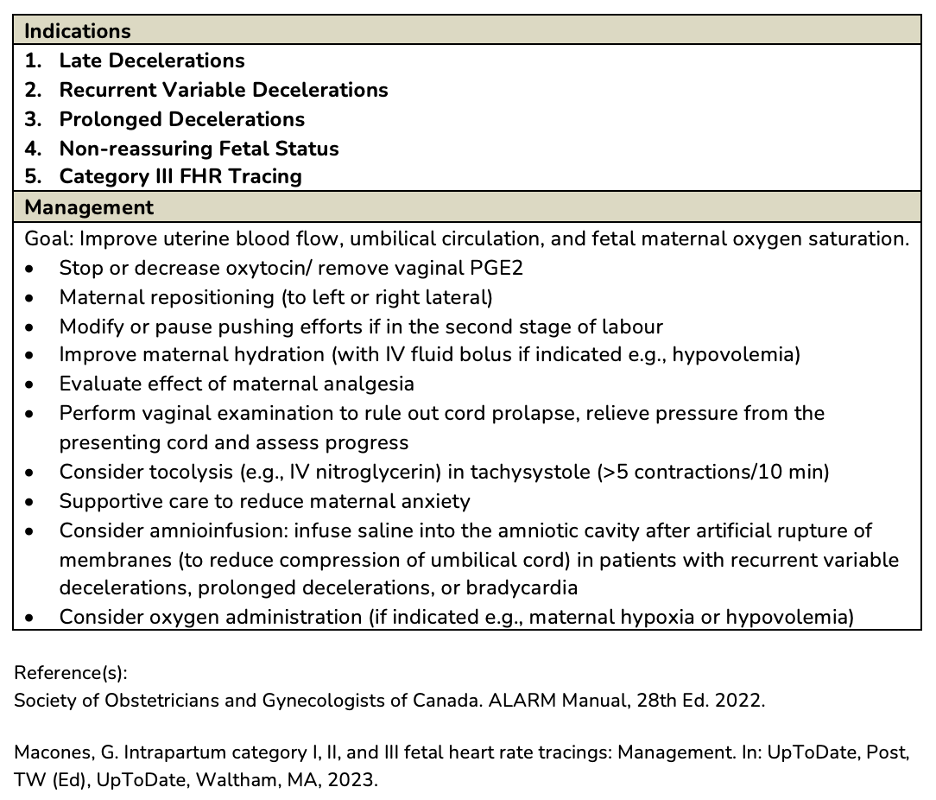
|
Antibiotics and GBS Prophylaxis |
|
Antepartum Management:
PPROM (<34 Weeks Gestation) – Antibiotic Treatment to reduce risk of chorioamnionitis, prolong the latency period, and reduce neonatal morbidity. · Option 1: Ampicillin (2g IV q6h) and Erythromycin (250mg IV q6h) for 48 hours, followed by Amoxicillin (250mg PO, q8h) and Enteric-Coated Erythromycin Base (333mg PO q8h) for 5 days (Mercer protocol) · Option 2: Erythromycin (250mg PO q6h for 10 days) · Option 3: Clarithromycin or Azithromycin in appropriate doses (below) Do NOT administer amoxicillin with clavulanic acid (increased risk of necrotizing enterocolitis in the presence of PROM). Intrapartum Management:
Membrane Rupture or Onset of Active Labour: Administer to all women with (1) previous infant with invasive GBS disease, (2) GBS bacteriuria during current pregnancy, (3) positive screening culture within the past five weeks. If GBS status is unknown: Administer for (1) preterm labour (<37 weeks), (2) rupture of membranes for >18h, (3) maternal fever >38 degrees Celsius. NOT Indicated: (1) Planned Caesarean Section (CS) in the absence of labour or membrane rupture (regardless of GBS status) and (2) Negative vaginal and rectal GBS screening culture within five weeks. Preterm labour with intact membranes:
Prelabour rupture of membranes (PROM) and preterm PROM (PPROM):
|
Society of Obstetricians and Gynecologists of Canada. ALARM Manual, 28th Ed. 2022.
Choosing a Debrief Framework:
A good debrief has been identified in the literature as the most important part of a successful simulation experience. If you're a novice or inexperienced facilitator, use this table to help you choose which debrief framework you want to use, just tap the button on their name and you will be directed to the appropriate aids or scripts. While we recommend the PEARLS framework, take a look to see if there may be another that is a better fit for your situation.
|
|
|||||
|
Time |
Facilitator Level |
Prep Time |
Scenario Type |
Flexibility |
|
|
Moderate |
Novice |
Moderate |
Any |
High |
|
|
Short-Moderate |
Novice |
Low |
Short w/ Clear Objectives |
Low |
|
|
Moderate |
Novice |
Moderate |
Any, esp. Team-focused |
Moderate |
|
|
Very Short |
No experience |
None |
Any |
Low |
|
|
Short |
Novice |
Low |
Low number of non-technical skills |
Low |
|
|
Very Short |
No experience |
None |
Any |
Moderate |
|
|
Moderate-Long |
Novice |
Moderate |
Any |
Moderate |
(To learn more about this debriefing framework, visit our page on Debriefing resources)
If you need help with debriefing Crisis Resource Management skills, check out this infographic from Isaak & Stiegler: View Infographic
|
Phase |
Objective |
Task |
Sample Phrases |
||
|
1. Setting the Scene |
Create a safe context for learning |
State the goal of debriefing; articulate the basic assumption |
“Let’s spend X minutes debriefing. Our goal is to improve how we work together and care for our patients.” “Everyone here is intelligent and wants to improve”
|
||
|
2. Reactions |
Explore feelings |
Solicit initial reactions and emotions
|
“Any initial reactions?” “How are you feeling?” |
||
|
3. Description |
Clarify Facts |
Develop a shared understanding of the case |
“Can you please share a short summary of the case?” “What was the working diagnosis? Does everyone agree?”
|
||
|
4. Analysis |
Explore a variety of performance domains:
|
See bottom of guide for details on the analysis phase |
For each item to be debriefed: 1. Preview Statement: (to introduce topic)
2. Pick Analysis method + Analyze: (see below for more info on each method)
3. Mini Summary: (to summarize discussion of topic)
Phase Wrap-up: "Any outstanding issues or concerns before we start to close?" |
||
|
5. Application or Summary |
Identify take-aways |
Can be learner- or instructor-centered |
Learner-centered: “What are some takeaways from this discussion for our clinical practice?”
Instructor-centered: “The key learning points for the case were [insert learning points]”
|
||
|
Analysis Phase Details |
|||||
|
Choose an analysis approach (Different approaches can be used for different topics within the same analysis stage): |
|||||
|
Approach |
Objective |
Sample Phrases |
|||
|
Learner Self-Assessment
|
Promote reflection by asking learners to assess their own performance |
“What aspects were managed well and why?”
“What aspects do you want to change and why?”
|
|||
|
Focused Facilitation
|
Probe deeper on key aspects of performance, uncover mental frames guiding performance |
Use Advocacy-Inquiry Method Advocacy: "I saw [observation], I think [your point-of-view]” "I noticed [observation] I liked that/I was concerned..." Inquiry: “How do you see it? What were your thoughts at the time?” |
|||
|
Provide Information
|
Teach to close clear knowledge gaps as they emerge and provide directive feedback as needed |
“I noticed[behaviour]. Next time you may want to consider [suggested behaviour], because [rationale]” |
|||
PDF from debrief2learn.org: Here
Visual Guide: debrief2learn.org
Alternative Script: Here
Originally Created by: Bajaj K, Meguerdichian M, Thoma B, Huang S, Eppich W, Cheng A. The PEARLS Healthcare Debriefing Tool. Acad Med. 2018, 93(2), 336.
(To learn more about this debriefing framework, visit our page on Debriefing resources)
If you need help with debriefing Crisis Resource Management skills, check out this infographic from Isaak & Stiegler: View Infographic
|
Phase |
Goal |
Actions |
Possible Scripts |
|
Gather (Listen)
25% |
|
|
How do you feel? |
|
How do you think it went? Can you tell me what happened? |
||
|
Can anyone add anything to that account? |
||
|
Analyze (Guide Reflection)
50% |
|
|
I noticed… |
|
I noticed…. What was the thought process behind…. When….happened, I saw….What do you think….. I saw…I think….How do you see it? |
||
|
Tell me more about… How did you feel about…. I understand, but tell me about X aspect of the scenario |
||
|
Summarize (Help gather Conclusions)
25%
|
|
|
What are two things that you thought were effective or went well? |
|
What do you think are some areas you/your team need to work on? |
||
|
In today’s session, we…. Going forward, we should…. |
References/Adapted From:
(To learn more about this debriefing framework, visit our page on Debriefing resources)
If you need help with debriefing Crisis Resource Management skills, check out this infographic from Isaak & Stiegler: View Infographic
Instructions:
|
Actions |
Gather |
Analyze |
Summarize |
|
Closed-loop communication
Clear Messages
Clear Roles
Knowing one’s limitations
Knowledge Sharing
Constructive Intervention
Reevaluation and Summarizing
Mutual Respect
|
Student Observations
Instructor Observations
|
Done Well
Needs Improvement
|
Student-led Summary
Instructor-led Summary
|
References/Adapted from:
(To learn more about this debriefing framework, visit our page on Debriefing resources)
If you need help with debriefing Crisis Resource Management skills, check out this infographic from Isaak & Stiegler: View Infographic
|
|
Set learning objectives |
|
After Case |
How did it go? Address Concerns Review learning points Plan ahead |
Framework from:
(To learn more about this debriefing framework, visit our page on Debriefing resources)
If you need help with debriefing Crisis Resource Management skills, check out this infographic from Isaak & Stiegler: View Infographic
|
Diamond Debrief: Sample Phrases |
|
Description |
|
“So what happened?...and then what happened next?”
Continue asking until confident that the details of the scenario have been raised by the learners
“Let’s not judge our performance now, let’s just focus on what happened” |
|
Transition |
|
“This scenario was designed to show…”
“Let’s address technical and clinical questions. What is the protocol for…?”
“How do we normally deal with this clinical situation?”
“Everyone ok with that?” |
|
Analysis |
|
“How did that make you feel?” To participants, then group “Why?” Then use silence
“How did you/they do that exactly?” “Why did you respond in that way? “ or “Why did you take that action?”
“It feels like…was an issue. Did it feel like that to you?” What I’m hearing from you is…is that correct?”
“This is part of…” (identify the non-technical skill/human factor) “We refer to that as a human factor or non-technical skill, which means…” |
|
Transition |
|
“So, what we’ve talked about in this scenario is…” “What have we agreed we could do?” |
|
Application |
|
“What other kinds of situations might you face that might be similar? How are they similar?”
“How might these skills we discussed play out in those situations?”
“What are you going to do differently in your practice going forward?” |
|
Underlying Principles |
|
Description |
|
Reinforce a safe learning environment. Situate the debrief in the shared and meaningful activity that occurred. Keep the focus dispassionate—discuss what happened but avoid focus on emotions. Listen for emotional responses but resist the temptation to discuss emotions. Make sure everyone shares the same understanding of what happened.
|
|
Transition |
|
Transition into analysis by clarifying any technical and clinical issues |
|
Analysis |
|
Spend most of your time in Analysis. Deconstruct behaviours into specific actions, and explore what happened in detail. Ask about affective responses and validate them. Analyze and interpret the activity by applying appropriate frameworks or lenses (such as non-technical skills, or the clinical context surrounding the scenario). Keep discussion positive, and avoid the temptation to focus on “strengths and weaknesses”. Reflect responses back, allowing participants to amend or augment. |
|
Transition |
|
Transition into Application by reinforcing learning. |
|
Application |
|
Focus on moving from the specifics of the scenario to the more general world of practice. Break behaviours down into specific actions. Explore the other kinds of situations that these might apply to. Ask what participants will do differently in their practice. |
Adapted From: Jaye P, Thomas L, Reedy G (2015). 'The Diamond': a structure for simulation debrief. The Clinical Teacher 12(1). 171-175. onlinelibrary.wiley.com/doi/full/10.1111/tct.12300
If you need help with debriefing Crisis Resource Management skills, check out this infographic from Isaak & Stiegler: View Infographic
Pluses:
Deltas:
|
Plus (+) |
Delta (∆) |
References:
((To learn more about this debriefing framework, visit our page on Debriefing resources)
If you need help with debriefing Crisis Resource Management skills, check out this infographic from Isaak & Stiegler: View Infographic
|
Phase |
Purpose |
Process |
Sample Phrases |
|
Reactions |
|
|
How are you feeling? What are some initial reactions to what just happened? So, in that scenario… |
|
Analysis |
|
1. Observe an event or result. Comment on the observation.
2. Advocate for your position |
I saw that… I think… I noticed that…To me…
I saw…I’m concerned that… |
|
3. Investigate basis for learner’s thinking that led to the observed event or result |
What do you think? Why do you think that happened? How do you see it? What was the thought process behind….? |
||
|
4. Close the gap through discussion and didactics |
I hear…. What would it take for you to do this next time? How could we do this differently next time? I think a few good ideas that came up were… I’d like to say a little bit about…from my experience/literature |
||
|
Summary |
|
|
What are some takeaways from today? What went well today? What would you do differently next time?
In today’s session, we…. Going forward, we should… |
Adapted from:
Fetal Heart Rate Monitoring:
Management: